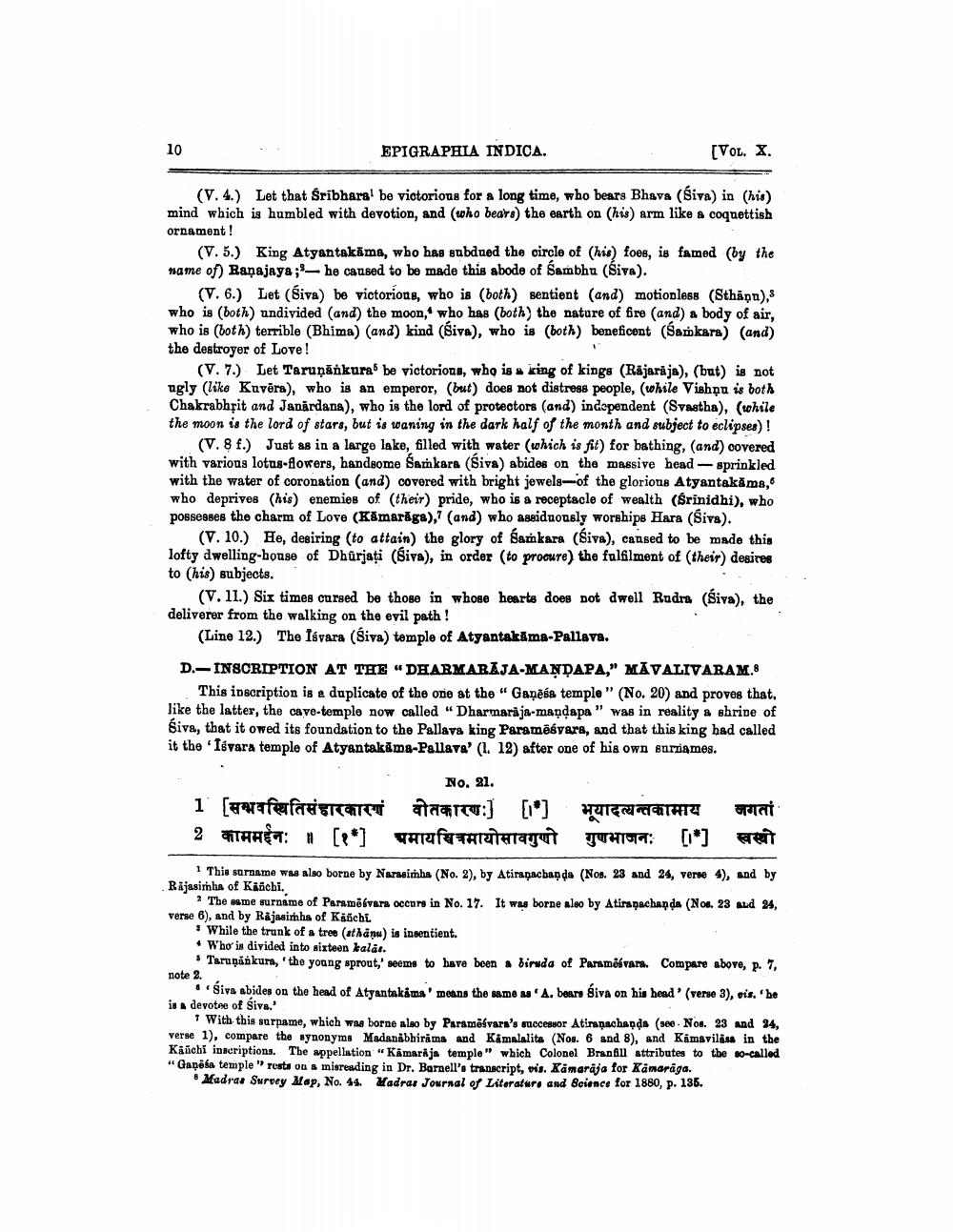________________
EPIGRAPHIA INDICA.
[VOL. X.
(V. 4.) Let that Sribharat be victorious for a long time, who bears Bhava (Śiva) in (his) mind which is humbled with devotion, and (who bears) the earth on (his) arm like a coquettish ornament !
(V.5.) King Atyantakāma, who has subdued the circle of (his) foes, is famed (by the name of) Raņajaya; he caused to be made this abode of Sambhu (Siva).
(V. 6.) Let (Śiva) be victorione, who is (both) sentient (and) motionless (Sthāņu), who is (both) undivided (and) the moon, who has (both) the nature of fire (and) a body of air, who is (both) terrible (Bhima) (and) kind (Śiva), who is (both) beneficent (Samkara) (and) the destroyer of Love!
(V. 7.) Let Taruņārkuras be victorious, who is a icing of kings (Räjarāja), (bat) is not ngly (like Kavēra), who is an emperor, (but) does not distress people, (while Vishņu is both Chakrabhfit and Janardana), who is the lord of protectors (and) independent (Svastha), (while the moon is the lord of stars, but is waning in the dark half of the month and subject to eclipses)!
(V. 8 f.) Just as in a large lake, filled with water (which is fit) for bathing, (and) covered with various lotus-flowers, handsome Samkara (Siva) abides on the massive head - sprinkled with the water of coronation (and) covered with bright jewels-of the glorious Atyantakāma, who deprives (his) enemies of (their) pride, who is a receptacle of wealth (śrinidhi), who POBsesses the charm of Love (Kamarága), (and) who assiduously worships Hara (Siva).
(V. 10.) He, desiring (to attain) the glory of Sankara (Śiva), caused to be made this lofty dwelling-house of Dhûrjați (Siva), in order to procure) the fulfilment of (their) desires to (his) subjects.
(V.11.) Six times cursed be those in whose hearts does not dwell Rudra (Śiva), the deliverer from the walking on the evil path!
(Line 12.) The Isvara (Siva) temple of Atyantakama-Palleva. D.-INSCRIPTION AT THE DEARMARĀJA-MANDAPA," MĂVALIVARAM.8
This inscription is a duplicate of the one at the " Gaņēša temple" (No. 20) and proves that, like the latter, the cave-temple now called "Dharmaraja-maqdapa" was in reality & shrine of Siva, that it owed its foundation to the Pallava king Paramāsyara, and that this king had called it the Isvara temple of Atyantakama-Pallava' (1. 12) after one of his own surnames.
No. 21. 1 [ fafareercent :) 1) 2 FTARCT: [*] warufu TATU Tayat
Heren HTHT
Hora: 0"]
Want Brut
This surname was also borne by Narasimha (No. 2), by Atiranacbanda (Nob. 23 and 24, verse), and by Rajasinha of Kancbi.
? The same surname of Paramofvera occurs in No. 17. It was borne also by Atiramachanda (No. 23 and 24, verse 6), and by Rajasimhs of Käichi.
. While the trunk of a tree (athanu) is insentient. • Who is divided into sixteen kalas.
. Taruņāókur, 'the yoang sprout,' seems to have been a biruda of Paramosvara. Compare above, p. 7, note 2.
• Siva abides on the head of Atyantakima' means the same as A. bears Siva on his head' (verse 3), pis.be is devotee of Siva.'
7 With this surname, which was borne also by Paramėávara's successor Atiranachepds (see. Nos. 33 and 34, verse 1), compare the synonyms Madanabhirama and Kamalalita (Nos 6 and 8), and Kimaviläs in the Kiichi inscriptions. The appellation "Kamarija temple" which Colonel Branfill attributes to the 80-called " Gapoba temple " testa ou a misreading in Dr. Barnell's transcript, vis. Kamaraja for Kamarága.
. Madras Survey Map, No. 44. Madras Journal of Literature and Science for 1880, p. 136.




